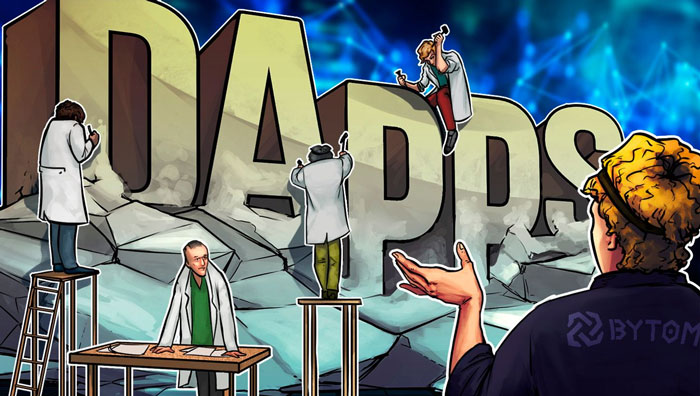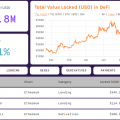
DApps (decentralized applications) are highly secure applications created on the basis of the blockchain. Byin essence, they are similar to smart contracts, but they can implement much more functions.
2019 ends with an increase in the number of users of dApps (decentralized applications), although the potential of such blockchain capabilities has yet to be fully realized.
Turnover weight of the entire dApps ecosystemTokens for the year exceeded $ 10 billion, and the number of active users is about 1 million per day. How does 2019 end for the dApps market and what does the industry expect in 2020?
What are DApps and how are they useful?
Decentralized applications are built on the basis of blockchain technology and integrated with it. The Ethereum white paper identifies three types of DApps:
- Financial applications.They give users the tools tofinancial management, both fiat and cryptographic. With their help, you can manage savings, wills, and draw up some types of full-fledged, comprehensive employment contracts.
- Partly financial decisions.They involve working with money, but are notmain focus. An example of such solutions could be self-developing systems of bonuses and points within loyalty programs. Typically, such points can be exchanged for real finance or material goods.
- Non-financial applications.Such programs have nothing to do withmoney. These could be services for personal identification, for conducting surveys and voting, for creating a system of government decisions, and decentralized file storage.
Market leaders in decentralized applications
In 2019, leadership among launch sitesdApps are powering the Ethereum (ETH) blockchain: the network's average daily dApps user base has grown by 118% year over year, and the volume of tokens involved has increased by 166% (in dollar terms).
Of the total number of launched and working dApps(3235) across all blockchains, the majority (2797) is on Ethereum, which is not surprising given the number of Ethereum developers: they created 520 new dApps in a year. Approximately every third unique dApp user runs a decentralized application on Ethereum. This network accounts for 81% of all smart contracts involved in the dApps ecosystem.
Although Ethereum has a large number of dApps, onlyEight applications are seeing significant user activity. The once very popular game CryptoKitties is now the fifth most popular game, behind BlockchainCuties, another gaming app that now has an average of 396 users per day. Further development of dApps of this network will be associated with the expected transformation of Ethereum into Ethereum 2.0 in 2020, and the emergence of eWASM - a new version of the Ethereum virtual machine (EVM). It is worth noting that there remains the problem of the rising price of gas, the internal financial unit in the Ethereum network, which was noted in December 2019.
The top three dApps placements also includeEOS and TRON blockchains. EOS statistics were spoiled by the situation with spam placement of EIDOS tokens, which was the result of a DDoS attack on the network. As a result, this negatively affected the speed of processing transactions on the network, and as a result, daily user activity in dApps on EOS fell by 48%. Now this figure averages 7390 unique digital wallets.
TRON has a better situation: The dApps ecosystem developed especially rapidly in the first half of the year, however, in the second half the pace fell, even though the number of open digital wallets for working with TRX tokens grew during the year. As a result, the number of dApps users on TRON grew over the year by 93%, but, unlike Ethereum, which developed along all the main types of dApps, TRON focused on gaming applications. TRON was also distinguished by the fact that a significant number of non-gaming dApps throughout 2019 not only did not gain a stable user base, but began to lose them.
The most promising blockchains for dApps
A group offourteen blockchains that in 2019 were used as networks to launch dApps and were well known to the crypto community. And the number of such networks in 2020 is sure to replenish, due to two factors:
- The development of blockchain technologies and the desire of developers to make more advanced products;
- Extend the practical applicability of dApps.
What are the most promising blockchains at the end of 2019?
- Iost. The main network was launched in February 2019years, works on the basis of the highly decentralized Proof-of-Believability protocol. The network has 39 dApps, of which the most popular (in June there was a peak of active digital wallets for the project - 7000, and the average result for the year - 1800) is the IOST Dex decentralized trading application, and the largest in terms of turnover is the iPirates gaming.
- Ontology. This is more than blockchain for dApps, asdevelopers are developing the project in a number of areas, focusing on solutions for “communicating” blockchains with each other. Nevertheless, 38 dApps were launched here, most of which are game project applications. The top dApps of this network are HyperDragons Go, as well as HyperSnakes, each of which has 500 daily active users. The peak of activity was observed in May, when Ontology recorded daily activity of users of 70,000 digital wallets, but as a result, the average figure for the year was a little more than 2000.
- Loom network. This second level solution allowsdevelopers to place dApps on a number of blockchains (Ethereum, TRON and Binance Chain), and will also add support for EOS and Cosmos networks in the future. Now 17 applications are available to users, mainly gaming. The most popular is CryptoZombies, the largest in terms of turnover is Axie Infinity. User activity throughout the year was relatively stable and averaged 500 digital wallets daily. The development potential of the project is also large: a number of applications, such as Relentless, CryptoWars and Sorare, are in the testing phase and will be presented in 2020.
- Thundercore. This blockchain is compatible with Ethereum and, according tothe idea of the founders, should ensure the safety of decentralized solutions and be distinguished by high bandwidth. At the same time, centralized network solutions increase the speed of dApps, the number of which is 10. Mostly these are gaming dApps, and the most popular of them is TTRoll. In May, a maximum of a year was recorded on the blockchain: more than 20,000 unique digital wallets were used on the network daily, with the average annual result not exceeding 500 users per day.
- Vechain. Implementation oriented projectblockchain technology into the work of corporate structures, as well as the development of the Internet of things (IoT). The blockchain employs 16 dApps, of which two eSports applications can be noted - Plair and PlayDECENT. Throughout the year, user activity was low, with an average of only 40 unique digital wallets per day.
- NEO. This blockchain is positioned as an open network.for a smart economy. In total, it runs 13 dApps, of which the most popular gaming NEOLand and Switcheo. In September there was a surge in activity - more than 2,000 active digital wallets, but the average for the year was 250.
- Waves. This blockchain has only recently becomeused to run dApps, which number is 21 applications. These are mainly game dApps, of which the most notable are Dice Roller, Coin Flip and Ride on Waves. The maximum of active digital wallets was observed in October - more than 500 per day, and as a result, this figure was about 200.
- WAX. The blockchain project was launched in December 2019.with a focus on gaming decentralized applications, and 26 dApps are already running on the network. The Prospectors game application and the KARMA social network are popular.
Not only games
In addition to these ecosystem participants, there arealso blockchains Steem, TomoChain, Klaytn, POA, xDai and GoChain. Among them, Steem still has high potential: it runs 92 dApps, and the most popular is the Splinterlands game application and the flagship Steemit application.
What is the main focus in dApps developments?is done on gaming applications (every second dApp is gaming) - this is a trend that is present not only in the blockchain sphere. For example, in the ranking of the top 10 video bloggers at the end of 2019, half are related to the gaming field.
But game projects have a significant drawback: they need to always be “afloat”. Otherwise, along with a drop in user interest, the value of in-game items will drop. So, for example, what happened in the case of the CryptoKitties application, when one of the main artifacts of the game, the “cryptocurrencies” Gen 0, greatly sank in price. At first they went at a price close to zero, rose within a few weeks to 0.1 ETH, at the peak of popularity they reached 6 ETH, and now they are again fluctuating around 0.1 ETH.
New horizons for dApps market development
At the same time, there are prospects for other directionsfor dApps development. Decentralized trading is one of them. Thus, one of the top dApps was the decentralized trading platform Binance DEX. However, even this app has faced heavy criticism from Ethereum co-founder Vitalik Buterin, who said on December 21 that he does not believe Binance provides a decentralized trading experience. Buterin is also unlikely to relent, even though Binance DEX added the ETH/BNB pair to the listing three days later.
At the same time, decentralized social dAppsnetworks are gaining popularity among users. This is evidenced by the fact that in November 2019, one of these projects (a dApp called Pepo) became the first decentralized social network application that was able to agree on cooperation with the Apple App Store and Google Store.
An important point will be the development of dApps support invarious mobile devices, including the creation of special libraries of decentralized applications. This is another step towards ensuring that dApps are freed from the status of “niche” developments aimed at gamers.
What VeChain does, that is, focuses onimplementation and use of blockchain and dApps in corporate structures will be carried out by other projects. The crypto community will see how decentralized applications will be successfully deployed in the energy, healthcare and finance sectors. But this requires the development of related technologies, as well as the massive distribution of cryptocurrencies and the adaptation of the blockchain.
</p> 5
/
5
(
1
vote
)



